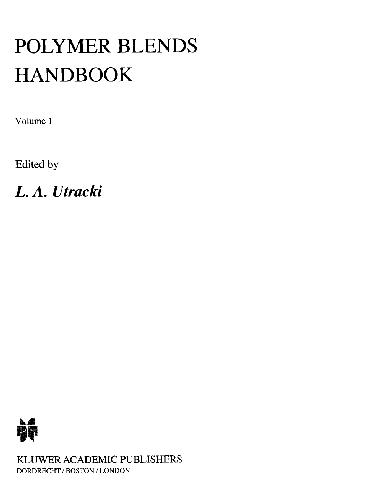Leszek A. Utracki1402011148, 9781402011146, 1402011105, 9781402011108, 1402011113
An electronic version of the Polymer Blends Handbook by Utracki is available.
Table of contents :
Front Matter……Page 1
List of Authors……Page 4
Preface……Page 7
Z……Page 0
Front Matter……Page 11
List of Authors……Page 14
Preface……Page 17
Table of Contents……Page 21
1. Introduction to Polymer Blends……Page 45
1.1.5 Synthetic Thermoplastic Polymers……Page 46
1.1.7 Development of Polymer Science……Page 48
1.2.1 Basic Considerations……Page 51
1.2.2 Polymer Nomenclature……Page 52
1.2.3 Copolymers……Page 54
1.2.5 Polymer Blend Terminology……Page 55
1.3 Introduction to Polymer Blends……Page 56
1.3.2 Compatibilization……Page 57
1.3.3 Morphology……Page 60
1.3.4 Rheology……Page 61
1.3.5 Developing Commercial Blends……Page 64
1.3.6 Blends’ Performance……Page 65
1.3.7 Evolution of Polymer Alloys and Blends……Page 68
2.1 Introduction……Page 69
2.2.1 Definitions……Page 70
2.2.2 Three Laws of Thermodynamics……Page 71
2.2.4 Multicomponent Systems……Page 72
2.3.1 Equation of State (EoS) or PVT Relationships……Page 73
2.3.2 Solid-Liquid and Vapor-Liquid Equilibria……Page 78
2.4.1 Polymer Solutions……Page 80
2.4.2 Polymer Blends – Definitions and the Miscibility of Blends……Page 81
3.1 Abstract……Page 85
3.2 General Introduction……Page 86
3.3 Crystallization, Morphological Structure, and Melting Behavior of Miscible Polymer Blends……Page 87
3.3.1 Crystallization Temperature Range of Crystallizable Miscible Blends……Page 88
3.3.2 Crystallization Phenomena in Miscible Polymer Blends……Page 90
3.3.3 Spherulite Growth of the Crystallizable Component……Page 94
3.3.4 Overall Crystallization Kinetics……Page 102
3.3.5 Melting Behavior of Crystallizable Miscible Blends……Page 109
4.1.2 Definition of the Surface and Interface Tension Coefficients……Page 118
4.2.1 Binary Immiscible Polymer Blends……Page 119
4.2.2 Copolymers……Page 122
4.2.3 Copolymer/Homopolymer Blends……Page 123
4.2.4 Blends of Two Homopolymers with a Compatibilizer……Page 125
4.2.5 Conclusions and Outlook……Page 129
4.3.1 Interfacial Tension Coefficient……Page 131
4.3.2 Interphasial Thickness……Page 137
5.1 Introduction and Purpose……Page 140
5.2 Definitions of Compatibilization and Polymer Alloys……Page 142
5.3 Types of Polymer Blends……Page 143
5.4 Characteristics of Immiscible Polymer Blends……Page 144
5.5.3 Addition of a Third Material as a Compatibilizing Agent……Page 146
5.6.1 Types of Redistribution Reactions and Characteristics……Page 148
5.7.1 Types of Grafting Reactions and Characteristics……Page 153
5.7.4 Polyamide + Polyolefin Binary Blends (Excepting Polypropylene)……Page 158
6.1.1 Definitions……Page 164
6.1.2 History of IPNs……Page 165
6.2 Synthetic Methods……Page 166
6.3 Morphology and Glass Transitions……Page 168
6.3.1 Morphology via Electron Microscopy……Page 169
6.3.2 Phase Diagram Control of SIN Morphology……Page 170
6.3.3 Glass Transition Behavior……Page 173
7.1.1 Rheology of Multiphase Systems……Page 175
7.1.2 Basic Concepts of Polymer Blends……Page 177
7.2.2 Homologous Polymer Blends……Page 183
7.3.1 Suspensions……Page 184
8.1 Abstract……Page 197
8.3.1 Optical Microscopy (OM)……Page 198
8.3.2 Transmission Electron Microscopy (TEM)……Page 199
8.3.3 Scanning Electron Microscopy (SEM)……Page 205
8.4.1 Image Processing……Page 206
8.4.2 Light Scattering……Page 207
8.5.1 Formation of Lamellar Crystals……Page 208
8.5.3 Blend Induced Crystallization……Page 210
9.1 Fundamentals of Polymer Mixing……Page 213
9.1.1 The Reasons for Mixing……Page 214
9.1.2 Laminar Mixing……Page 215
9.1.3 Chaotic Mixing……Page 217
9.1.4 Dispersive Mixing – Microrheology……Page 218
9.1.6 Mixing in Extensional Flow Field……Page 223
9.1.7 Interphasial Properties……Page 227
9.1.8 Coalescence……Page 228
9.1.9 Measures of Mixedness……Page 230
9.1.10 Morphology Evolution during Processing……Page 231
10.1 Abstract……Page 238
10.2.1 General Description of Polymer Forming……Page 239
10.2.2 Influence of Material Characteristics……Page 240
10.3.1 Introduction……Page 245
10.3.2 General Behavior of Blends During Forming……Page 246
10.3.3 Forming Blends of Commodity Polymers……Page 256
10.3.4 Forming Blends of Engineering Polymers……Page 260
11. Use of High-Energy Radiation in Polymer Blends Technology……Page 265
11.2.1 Saturated Hydrocarbons……Page 266
11.2.2 Aromatic Hydrocarbons……Page 270
11.2.3 Halogenated Organic Compounds……Page 271
11.3 Radiation Effects on Polymers……Page 272
11.3.1 Polyethylene, PE……Page 275
11.3.2 Polypropylene, PP……Page 276
11.3.3 Polyvinylchloride, PVC……Page 278
11.3.4 Polystyrene, PS……Page 279
11.3.5 Polymethylacrylate, PMMA……Page 280
11.3.6 Elastromers……Page 281
12.1 Abstract……Page 283
12.2 Introduction……Page 284
12.3.1 Tensile Strength, Tensile Modulus, Elongation……Page 285
12.3.2 Compressive Strength……Page 287
12.3.3 Flexural Strength and Flexural Modulus……Page 289
12.3.5 Fatigue Characteristics……Page 291
12.3.6 Low-speed Mechanical Properties of Blends……Page 293
12.4.1 Impact Strength……Page 294
12.4.2 Fracture Mechanics……Page 300
12.4.3 Fracture Mechanics Testing……Page 303
12.4.4 Mechanisms of Toughening……Page 307
12.4.5 Factors Affecting Blend Toughness……Page 309
13.1 General Principles for the Use of Polymer Blends……Page 317
13.2 Automotive Applications……Page 320
13.2.1 Under the Hood Applications……Page 322
13.2.2 Exterior Applications……Page 323
13.2.3 Interior Applications……Page 327
13.3 Lawn and Garden……Page 330
13.4 Electrical and Electronics Applications……Page 331
13.5 Medical Applications……Page 333
13.6 Building and Construction……Page 335
13.7 Business Machines and Communications……Page 336
13.8 Packaging……Page 339
13.9.4 Appliances……Page 340
13.10 References……Page 341
13.11 List of Abbreviations……Page 342
14.1 Abstract……Page 343
14.3.1 Fundamental Principles……Page 344
14.3.2 Physical Aging in Polymer Blends……Page 347
15.1 Abstract……Page 366
15.2.1 Compatibilization Mechanisms in Commercial Polymer Blends……Page 367
15.2.2 Rationale for Polymer Blends……Page 373
15.3 Polyolefin Blends……Page 375
15.3.1 Blends Based on Polyethylenes……Page 376
15.3.2 Blends Based on Polypropylene……Page 378
15.3.4 Reactor-Made Polypropylene/Non-Olefinic Polymer Alloys……Page 381
15.3.5 Metallocene Polyolefin Blends……Page 384
15.4.1 Polystyrene and High Impact Polystyrene (HIPS) Based Blends……Page 385
15.4.2 ABS Blends……Page 388
15.4.3 Acrylic-Styrene-Acrylonitrile (ASA) Terpolymer Based Blends……Page 392
15.4.4 Styrene-Maleic Anhydride (SMA) Copolymer and Terpolymer Based Blends……Page 395
16.2 Introduction……Page 397
16.2.1 Sources of Plastics Waste……Page 398
16.2.2 The Methods of Plastics Recycling……Page 400
16.2.3 Plastics Recycling – Examples……Page 403
16.3.1 Thermodynamics……Page 406
16.3.2 Compatibilization of Polymers……Page 407
16.3.3 Rheology……Page 409
16.3.5 Evolution of Morphology during Processing……Page 410
16.4.1 Degradation and Stabilization during Processing……Page 411
16.4.3 Stabilization – Effects of Additives……Page 416
16.5.1 Separation Methods……Page 417
16.5.3 Examples……Page 419
17.1 The Past and Present: Relevance to the Future……Page 420
17.2 Perspectives in the Future Developments in Commodity Polymer Blends……Page 424
17.3 Engineering Polymer Blends: Future Perspective……Page 427
17.4 High Temperature Polymer Blends……Page 431
17.4.1 Molecular Composites……Page 432
17.4.2 Liquid Crystalline Polymer Blends……Page 434
17.5 Electrically Conductive Polymer Blends……Page 435
Appendix I: International Abbreviations for Polymers and Polymer Processing……Page 439
A……Page 453
B……Page 458
C……Page 462

Reviews
There are no reviews yet.